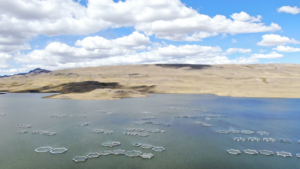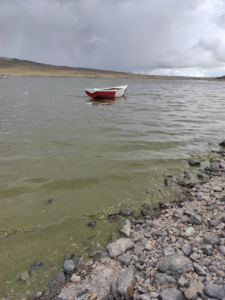Harmful algal blooms, a toxic threat.
There are small organisms in water (algae) that can cause harm.
Cyanobacteria or blue-green algae are microorganisms with characteristics of both algae and bacteria. Under favorable environmental conditions, a phenomenon known as “algal bloom ” occurs. We call “algal bloom” when there is an excessive growth of microalgae.

El Pañe reservoir Arequipa, Peru. Source: TOXICROP project.
Factors that favor the development of algal blooms:
- The discharge of nutrients, mainly nitrogen and phosphorus, from agricultural, industrial, and domestic activities affects natural waters. This loss of water quality is called eutrophication.
- Long residence time of water within an ecosystem favors the growth of cyanobacteria over microalgae.
- Temperature, pH, light, and water turbulence are important.
Cyanobacterial blooms can cause problems in water quality due to their growth and quantity. They produce excess biomass, resulting in physical, chemical, and biological changes in the ecosystems. Furthermore, cyanobacteria can produce toxins that are harmful. It is estimated that more than 50% of algal blooms are toxic.

Algal bloom in El Pañe reservoir, Perú. Source: TOXICROP project
The toxins produced by cyanobacteria are also known as cyanotoxins. They can cause skin irritation when in contact with the skin, but more severe health symptoms occur if consumed.
To prevent human exposure and health issues, cyanobacteria need to be monitored, by sampling periodically, and perform microscopic analysis and testing toxicity. If a toxic bloom is confirmed, the proper measures should be put in place.


